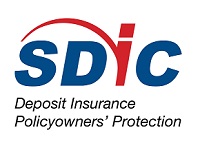
Deposit Insurance Scheme
A: The Deposit Insurance (DI) Scheme protects insured deposits held with a full bank or finance company. Insured depositors will be compensated up to a maximum of S$100,000 in the event a DI Scheme member fails.
A: In the event a DI Scheme member fails, Monetary Authority of Singapore (MAS) may request SDIC to step in.
SDIC will pay insured depositors as soon as possible. Payment will be made by Paynow (using NRIC/FIN/UEN), or by cheques or cashier’s orders.
SDIC will make the compensation from the DI Fund which is built up from the premiums that DI Scheme members pay annually.
A: Individuals and non-bank depositors such as sole proprietorships, partnerships, companies and other unincorporated entities like associations and societies are covered under the DI Scheme.
A: The DI Scheme covers the following Singapore dollar denominated deposits placed with a DI Scheme member in any of its branches in Singapore:
· A deposit held in a savings account
· A deposit held in a fixed deposit account
· A deposit held in a current account
· Any monies placed under the CPF Investment Scheme
· Any monies placed under the CPF Retirement Sum Scheme
· Any monies placed under the Supplementary Retirement Scheme
· Other products, as prescribed by MAS
If you want to know if your financial institution is a DI Scheme member, please refer to the complete List of DI Scheme members.
A: Singapore dollar deposits of non-bank depositors such as individuals, sole proprietors, partnerships, companies and unincorporated entities like associations and societies held with members of the DI Scheme are covered. You can request for a register of insured deposits from any DI Scheme member to find out which deposit products are covered. Also, the account opening forms, deposit account statements and marketing materials will display the DI Scheme disclosure statement if the product is insured.
A: The DI Scheme does not cover foreign currency deposits, structured deposits and investment products such as unit trusts, shares and other securities.
A: The main objective of deposit insurance is to protect the core savings of small depositors. Foreign currency deposits and structured deposits are similar to investment products where the investor is required to assume higher risk for the potentially higher return. Such products do not typically form part of the core savings or transaction accounts of small depositors.
A: All full banks and finance companies in Singapore (unless otherwise exempted by MAS) are required to be members of the DI Scheme. However, wholesale and merchant banks are not required to be members. So a foreign bank which has a full-banking license will be included under the DI Scheme. If you want to know if your financial institution is a DI Scheme member, please refer to the complete list of DI Scheme members.
A: Singapore dollar deposits in savings accounts, fixed deposit accounts, current accounts and monies placed under the Supplementary Retirement Scheme are insured for up to S$100,000 in aggregate per depositor per Scheme member. Monies placed under the CPF Investment Scheme and CPF Retirement Sum Scheme are aggregated and separately insured up to S$100,000. Trust and client accounts are insured up to S$100,000 per account without aggregation. For more information, you may refer to Calculation of Compensation.
A: The DI limit of S$100,000 is applied on a per depositor per Scheme member basis. The deposits in your savings account and fixed deposit account with Bank A will be aggregated and covered up to S$100,000. Only trust and client accounts are separately insured on a per account basis.
A: The DI limit of S$100,000 is applied on a per depositor per Scheme member basis. This means that your deposits will be covered for up to S$100,000 for each bank.
A: For joint accounts, SDIC will divide funds in the joint account evenly unless the DI Scheme member has records that show otherwise. Each account holder’s share is then combined with his or her own accounts and the total amount of insured deposits is then covered for up to S$100,000. For example, if you and your husband have a joint account with a balance of S$90,000, and you have a separate account of S$60,000, your total deposits of S$105,000 will be covered up to the maximum of S$100,000. If you want to know more about the calculation of deposit insurance coverage for joint accounts, please refer to Calculation of Compensation.
A: Insured deposits in a person’s own name, and in the name of his/her sole proprietorship held with the same Scheme member, will be aggregated. If you want to know more about the calculation of deposit insurance coverage for sole proprietorship accounts, please refer to the Calculation of Compensation.
A: A partnership is treated as a single entity for the purpose of DI compensation and no aggregation of its insured deposits with insured deposits of its partners is applied. Assume a partnership with three partners – A, B and C and they have a deposit of S$120,000 with a Scheme member. Partner A maintains S$30,000 with the same Scheme member in a personal savings account. In the event of a DI payout, the partnership will be entitled to a compensation of S$100,000 as a single entity with a Scheme member. Partner A will receive S$30,000 in his/her own personal capacity.
A: Deposits held in trust and client accounts by non-bank depositors are insured on a per account basis up to S$100,000. If you want to know more about the calculation of deposit insurance coverage for trust and client accounts, please refer to Calculation of Compensation.
A: If you have insured deposits with both Bank A and Bank B and the combined balance exceeds S$100,000 immediately before the merger, your deposits will be insured by SDIC for up to S$200,000 for one year after the transfer. In determining the total protection limit during this one-year period, SDIC will combine the separate protection limits of your deposits from Bank A and Bank B into a single protection limit. For example, if you have S$60,000 in Bank A and S$120,000 in Bank B immediately before the merger, you will have protection limits of S$60,000 and S$100,000 from SDIC, respectively. In this example, the total protection limit of the insured depositor will be S$160,000.
A: There is no impact on your coverage even if you have pledged your deposit. The DI Scheme will insure pledged deposits up to the S$100,000 limit.
A: SDIC administers the DI Scheme in Singapore. The board of SDIC is accountable to the Minister in charge of MAS. If you want to know more about SDIC, please refer to Organisation.
A: Singapore’s banking system is known to be safe and well regulated. MAS has rules to ensure that banks and finance companies are well managed, well capitalised and have enough liquidity to meet any unforeseen needs.
A: SDIC is not part of the government. SDIC is a company limited by guarantee under the Companies Act. However, SDIC has been designated to be the Deposit Insurance and Policy Owners’ Protection Fund Agency under the Deposit Insurance and Policy Owners’ Protection Schemes Act 2011. The board of SDIC is also accountable to the Minister in charge of MAS.
A: Coverage is automatic. There is no need to fill out any application form or pay any premium. But do remember to keep your bank updated on your personal details such as name, ID number, mobile number and address. You should also register for Paynow using your NRIC/FIN/UEN number so that you can receive any compensation payment properly.
A: MAS may decide that a deposit insurance payout should be made if:
- A court order has been made to wind up a DI Scheme member; or
- MAS has determined that a DI Scheme member is insolvent, unable or likely to become unable to meet its obligations, or about to suspend payments.
A: Nothing. If your bank or finance company which is a DI Scheme member fails, you do not need to file claims with SDIC as payouts will be computed based on the records provided by of the failed bank or finance company to SDIC. SDIC will make official announcements in the Government Gazette, through mass media such as newspapers, television, radio and SDIC’s website. Information on deposit insurance payouts will be made via press releases and SDIC’s website.
SDIC will also submit a claim to the liquidator on your behalf for amounts in excess of S$100,000 and the liquidator will contact you directly on the outcome of these claims.
A: SDIC will pay insured depositors as soon as possible. Payment will be made by Paynow (using NRIC/FIN/UEN) sent to your registered mailing address with the failed bank. SDIC’s target is to send out most of the payments to depositors within seven working days after payout is activated by MAS. We encourage you to register for Paynow using your NRIC/FIN/UEN number so that you can receive any compensation payment properly.
A: The Insured Depositors’ login portal will be enabled on SDIC’s website if a bank fails and payout is activated by MAS. The portal allows you to log in to view your insured deposits with the failed bank and compensation amounts under the DI Scheme. Statements will also be sent to your registered mailing address with the failed bank. More information will be made available on SDIC’s website when the event happens.
